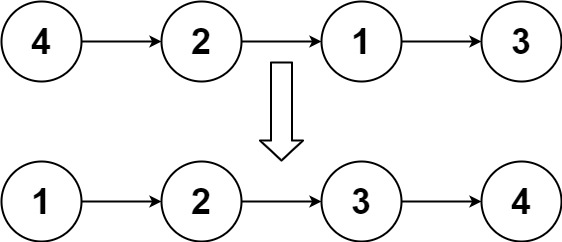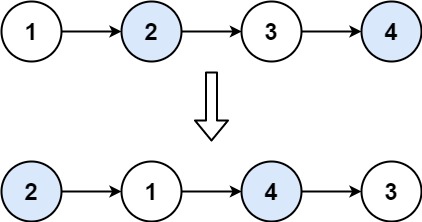Given the head of a linked list, return the list after sorting it in ascending order.
Follow up: Can you sort the linked list in O(n logn) time and O(1) memory (i.e. constant space)?
Example 1:

Input: head = [4,2,1,3] Output: [1,2,3,4]
Example 2:

Input: head = [-1,5,3,4,0] Output: [-1,0,3,4,5]
Example 3:
Input: head = [] Output: []
Constraints:
- The number of nodes in the list is in the range
[0, 5 * 104]. -105 <= Node.val <= 105
Idea:
Merge Sort (use slow and fast pointer to find the middle of the linked list and split them)
Time Complexity: O(nlogn)
Solution:
/**
* Definition for singly-linked list.
* function ListNode(val, next) {
* this.val = (val===undefined ? 0 : val)
* this.next = (next===undefined ? null : next)
* }
*/
/**
* @param {ListNode} head
* @return {ListNode}
*/
var sortList = function(head) {
// empty or one node
if (head === null || head.next === null)
return head;
let mid = getMid(head);
let left = sortList(head);
let right = sortList(mid);
return merge(left, right);
};
function merge(list1, list2) {
let newHead = new ListNode();
let tail = new ListNode();
tail = newHead;
while (list1 !== null && list2 !== null) {
if (list1.val < list2.val) {
tail.next = list1;
list1 = list1.next;
tail = tail.next;
} else {
tail.next = list2;
list2 = list2.next;
tail = tail.next;
}
}
tail.next = (list1 !== null) ? list1 : list2;
return newHead.next;
};
function getMid(head) {
let slow = head;
let fast = head;
let midHead = null;
while (fast !== null && fast.next !== null) {
midHead = slow;
slow = slow.next
fast = fast.next.next;
}
let secondHalf = midHead.next;
// !!!Important here:
// disconnect, split them into two lists
midHead.next = null;
return secondHalf;
}




